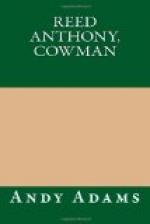After finishing the corral we hunted a week. The country was alive with game of all kinds, even an occasional buffalo, while wild and unbranded cattle were seen daily. None of the men seemed anxious to leave the valley, but the commissary had to be replenished, so two of us made the trip to Belknap with a pack horse, returning the next day with meal, sugar, and coffee. A cabin was begun and completed in ten days, a crude but stable affair, with clapboard roof, clay floor, and ample fireplace. It was now late in September, and as the usual branding season was at hand, cow-hunting outfits might be expected to pass down the valley. The advantage of corrals would naturally make my place headquarters for cowmen, and we accordingly settled down until the branding season was over. But the abundance of mavericks and wild cattle was so tempting that we had three hundred under herd when the first cow-hunting outfits arrived. At one lake on what is now known as South Prairie, in a single moonlight night, we roped and tied down forty head, the next morning finding thirty of them unbranded and therefore unowned. All tame cattle would naturally water in the daytime, and anything coming in at night fell a victim to our ropes. A wooden toggle was fastened with rawhide to its neck, so it would trail between its forelegs, to prevent running, when the wild maverick was freed and allowed to enter the herd. After a week or ten days, if an animal showed any disposition to quiet down, it was again thrown, branded, and the toggle removed. We corralled the little herd every night, adding to it daily, scouting far and wide for unowned or wild cattle. But when other outfits came up or down the valley of the Clear Fork we joined forces with them, tendering our corrals for branding purposes, our rake-off being the mavericks and eligible strays. Many a fine quarter of beef was left at our cabin by passing ranchmen, and when the gathering ended we had a few over five hundred cattle for our time and trouble.




